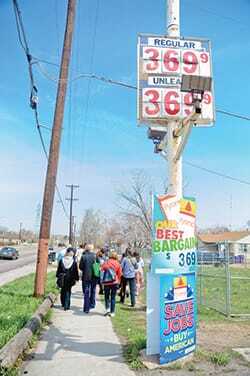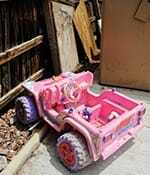The ULI Building Healthy Places Initiative, which will incorporate all components of the global organization, kicked off this spring with a special series of Advisory Services panels convened in three different types of communities in Colorado at the request of the Colorado Health Foundation, which has its own Healthy Places initiative. ULI senior resident fellow Ed McMahon, who was chair of the three panels, offers his observations.
Healthy Places: Designing an Active Colorado is a five-year, $4.5 million initiative sponsored by the Colorado Health Foundation (CHF). The goal of Colorado’s Healthy Places initiative is to reduce and prevent obesity by fostering a built environment where it is easy to walk, play, and engage in daily activities that encourage movement and connection with other people.
In late 2012, the CHF received 26 requests for participation (RFPs) from communities across Colorado. In the competitive RFP process, communities were asked to demonstrate their readiness and ability to engage stakeholders in identifying and addressing improvements to the built environment that would encourage active living. The three selected communities were Arvada, a first-ring suburb of Denver; Lamar, a small town in rural eastern Colorado; and Westwood, a densely populated, primarily Hispanic neighborhood in Denver.
The CHF and its local partners asked ULI to conduct Advisory Services panels—a signature program of ULI designed to make candid, independent recommendations on questions posed by the sponsor—in each of the three communities.
ULI’s panels are made up of carefully selected experts who volunteer their time and expertise. The panelists came to Colorado from all regions of the country and had expertise in real estate, community planning, landscape architecture, public health, economic development, and other disciplines.
Related Content: Arvada | Lamar | Westwood
ULI is embarking on a novel, organization-wide program over the next two years that seeks to address one of the most compelling issues of our day—the health and fitness of populations—by guiding the design and creation of the built environments in which people live, work, shop, and play. Learn More at ULI.org/health .
In each community, the ULI panel interviewed 75 to 100 local residents, business owners, and officials. Panel members toured each community on foot and by bus. They were briefed by the project sponsors and reviewed lengthy briefing books prepared for the event. They then spent several days in each community evaluating what they had learned and formulating recommendations specific to each community. The following are some of the lessons learned.
- There is no one-size-fits-all solution for creating a healthy community. Each community is different, so each community requires a unique set of solutions tailored to overcoming its liabilities and taking advantage of its key assets.
- In every community studied—urban, suburban, and rural—the design of buildings, streets, and neighborhoods to some degree makes physical activity unnatural, difficult, or dangerous, especially for children, the elderly, or people who are disabled. For example, in every community, sidewalk connections between neighborhoods and major activity centers like schools, parks, and shopping areas were nonexistent or incomplete. Even where sidewalks existed, often they were so narrow that two people could not walk abreast.
- In order for a healthy communities initiative to gain traction, local business leaders and elected officials must think long and hard about the connections between economic development and health. In Lamar, for example, the panel learned that organized sports (primarily baseball and football) and outdoor recreation (particularly rodeo and equestrian activities) are major attractions for visitors. Therefore, one of recommendations for Lamar is to think about sports and recreation facilities not just as nice amenities, but as necessities for economic development.
- People will not walk as part of their daily routine unless at least two ingredients are present: attractive or important destinations to walk to (such as a healthy downtown, a major park, or a school), and a route that is safe and interesting. People simply do not like to walk along busy arterial streets, past empty parking lots, or along ugly commercial strips.
- Creating healthy places is only partially about making changes in the built environment; it is also about programs and activities. It is one thing to provide a park or to build a sidewalk; it is another to get people to use the park or sidewalk. For example, the panel learned in one community that a child had been assaulted while walking to school alone. In a case like this, even the most complete and well-designed sidewalk network will not be enough to overcome parents’ fears about letting their children walk to school alone. The solution: “walking school buses"—a program in which the school system organizes teams of volunteer parents to walk designated routes to and from school each day, picking up and dropping off children much as a school bus would.
Each panel of experts made recommendations for the programming of parks, plazas, and open space. For example, it is not enough to just build a new downtown park; the park needs to have a regular schedule of activities such as Zumba classes, health fairs, farmers markets, or community celebrations. For a space to become a place, people and activities are needed.
- It was immediately clear to the real estate and land use experts on the panel that many principles of healthy design are the same as those long recommended by sustainability and smart-growth advocates for reducing the impact of the automobile—for example, density, street connectivity, and mixed uses.
- While the design of a community can have a crucial influence on public health, it can also affect the cultural, social, and economic well-being of a community and its residents. Today there is ample evidence to support the idea that communities that are pedestrian friendly can also command a premium in the real estate marketplace. For example, a one-point increase in a community’s Walk Score—a popular measure of a neighborhood’s walkability and the convenient access to goods and services—can correspond with a $3,000 increase in property values, according to the 2009 report Walking the Walk by CEOs for Cities.
The amount of money being spent in the United States on chronic diseases related to obesity and physical inactivity is rising rapidly. It is in the mutual interest of the real estate and public health communities to work together to create communities where the “healthy choice is the easy choice.”
The Building Healthy Places Initiative leverages the power of ULI’s global networks to shape projects and places in ways that improve the health of people and communities. Learn more.






